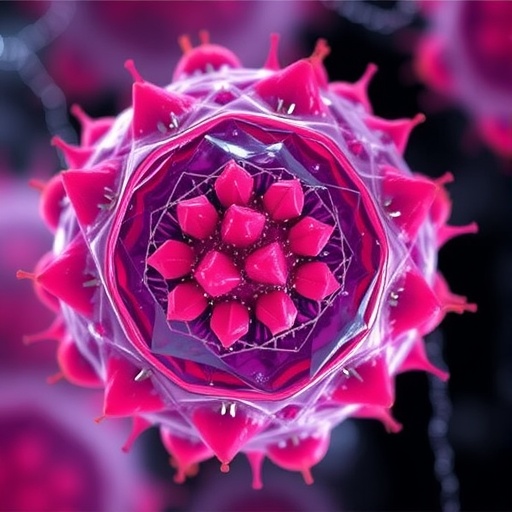
In an era where cellular biology continually pushes the boundaries of our understanding of life at its most fundamental level, a new study sheds light on a fascinating and previously underestimated aspect of cellular response mechanisms. The research conducted by Singh and Mittal, recently published in Cell Death Discovery, reveals the strikingly non-uniform effects that extracellular osmotic fluctuations impose at the subcellular scale, challenging long-standing assumptions and providing profound insights that could revolutionize approaches in cell physiology, pathophysiology, and therapeutic development.
Cells, as the quintessential units of life, constantly face and adapt to a dynamic extracellular environment. Among the numerous physical and chemical stresses they encounter, osmotic pressure variations—a consequence of shifts in solute concentration outside the cell—play a critical role in determining cellular fate. Traditionally, it has been widely held that osmotic changes affect cells uniformly, precipitating generalized volumetric and mechanical responses. However, Singh and Mittal’s investigation reveals that this perspective overlooks the intricate heterogeneity within individual cells, where disparate subcellular regions respond differentially to osmotic stress.
Employing an integrated combination of high-resolution imaging, biophysical measurements, and computational modeling, the study meticulously uncovers the spatially resolved dynamics of osmotic influences. By exquisitely controlling extracellular solute concentrations and observing the mechanical and morphological perturbations within cells, researchers demonstrated that the impact of osmotic pressure is unevenly distributed, with certain subcellular domains undergoing pronounced deformation while others remain relatively stable. This non-uniformity, they argue, is not a mere byproduct of cellular architecture but a fundamental feature influencing cell signaling and survival pathways.
One pivotal insight emerged from their use of advanced fluorescence microscopy to track the behavior of the cytoskeleton—a meshwork of protein filaments that provides structural support and mediates intracellular transport. The cytoskeleton displayed region-specific responses to hyperosmotic and hypoosmotic conditions, with localized contractions and expansions generating differential tension patterns. These mechanical heterogeneities could in turn modulate mechano-sensitive ion channels and receptors, triggering signaling cascades that lead to variable cellular outcomes such as apoptosis, autophagy, or adaptive remodeling.
Moreover, the researchers delved into the behavior of membrane-bound organelles, such as mitochondria and lysosomes, which appeared to react distinctively to osmotic shifts. Notably, mitochondrial morphology and distribution altered in specific subregions, implicating osmotic stress in the spatial regulation of energy metabolism and reactive oxygen species generation. Such findings underscore a nuanced interplay where osmotic environments could locally govern metabolic states, potentially influencing cellular aging and responses to injury.
The non-uniform subcellular impact also manifests prominently in nuclear mechanics. Singh and Mittal observed that nuclear shape and chromatin organization showed differential sensitivity across various loci, suggesting localized alteration of gene expression as a cell-level adaptive mechanism. This spatially restricted nuclear remodeling under osmotic stress challenges the conventional idea of a homogenous nuclear response and opens exciting avenues for understanding how micro-environmental conditions influence epigenetic landscapes.
Another critical aspect highlighted in the paper involves the cytoplasmic rheology—the fluid-like and elastic properties of the cytosol. Through micro-rheological techniques, the study demonstrated that osmotic variations induce uneven modifications in the viscosity and elasticity of cytoplasmic compartments. This heterogeneity impacts molecular diffusion and the transport of signaling molecules, potentially altering the timing and integration of intracellular communication networks during stress responses.
From a biophysical modeling standpoint, the team developed sophisticated computational frameworks that incorporate these subcellular mechanical disparities to predict cellular outcomes. Their models suggest that non-uniform osmotic responses confer an evolutionary advantage by enabling cells to compartmentalize damage and tailor repair processes selectively, rather than initiating broad, energetically costly strategies. This localized precision in stress handling may be particularly relevant in tissues exposed to rapid fluid shifts, such as renal epithelia or brain cells amid edema.
The implications of these findings stretch beyond fundamental biology. In pathological conditions like ischemia, trauma, and cancer—where fluid imbalances and osmotic shifts are common—understanding the heterogeneous subcellular responses may guide the development of targeted interventions. For example, by manipulating extracellular osmolarity with enhanced precision or designing drugs that modulate mechano-sensitive pathways specifically in vulnerable subcellular regions, clinicians could improve therapeutic efficacy and minimize side effects.
Additionally, in the rapidly advancing field of tissue engineering and regenerative medicine, insights into how osmotic stress differentially affects cellular sub-domains could inform the design of biomaterials and scaffolds that better mimic physiological conditions. Such biomimicry would optimize cell viability, function, and integration into host tissues by fostering favorable microenvironmental conditions that recognize the cell’s intrinsic heterogeneity.
The article further highlights the technological innovations instrumental in uncovering these phenomena. Utilizing next-generation live-cell imaging combined with quantitative image analysis allowed the researchers to monitor real-time responses with unprecedented spatial and temporal resolution. These methodological advancements not only bolster the credibility of their findings but also set new standards for investigating biomechanical processes in living cells.
Singh and Mittal’s study also sparks intriguing questions about the molecular mechanisms orchestrating this subcellular non-uniformity. The differential expression or localization of osmotic sensors, ion channels, and cytoskeletal regulators probably plays essential roles, yet the specifics remain to be elucidated. Future research may delve into identifying these molecular determinants and their regulation under physiological and pathological osmotic conditions.
Furthermore, the study challenges researchers to reconsider how experimental models represent osmotic stress. Traditional bulk measurements and population-wide assays might mask crucial variations that occur at the subcellular scale. Adopting single-cell and subcellular resolution approaches could therefore yield more accurate insights and predictive models for cellular behavior in fluctuating environments.
Importantly, this work opens the door to a more integrative understanding of how mechanical forces and biochemical signals converge to dictate cell fate decisions. The discovery that osmotic pressures are not uniform but spatially nuanced invites a reevaluation of cell biology paradigms, urging scientists to adopt a more detailed, localized perspective when interpreting cellular responses and designing experiments.
This revelation about non-uniform osmotic effects is poised to be transformative. By reframing osmotic stress from a global, homogenous force to a localized, complex challenge, the study embraces the cell’s inner complexity. It reflects a broader trend in biological sciences—moving beyond simplified models toward embracing heterogeneity and spatial intricacy as central factors in life’s processes.
In conclusion, the research by Singh and Mittal profoundly enriches our grasp of cellular dynamics by exposing the uneven terrain of osmotic influence beneath the cell surface. Their multi-faceted approach combining experimental finesse and computational rigor highlights a critical dimension of cell biology that has remained in the shadows. As these findings ripple through the scientific community, they will undoubtedly inspire new lines of inquiry, technology development, and clinical strategies, reinforcing the intricate beauty and resilience embedded within cellular life.
Subject of Research: Non-uniform subcellular effects of extracellular osmotic variations.
Article Title: Non-uniform impact of extracellular osmotic variations at subcellular level.
Article References:
Singh, P., Mittal, A. Non-uniform impact of extracellular osmotic variations at subcellular level. Cell Death Discov. 11, 410 (2025). https://doi.org/10.1038/s41420-025-02703-6
Image Credits: AI Generated
DOI: https://doi.org/10.1038/s41420-025-02703-6
Tags: cellular responsesleading to varied outcomes in cell viability and function. This revelation has significant implications for understanding disease mechanismsthe authors demonstrate that specific organelles exhibit distinct behaviors under osmotic stress





